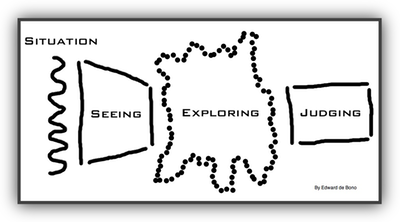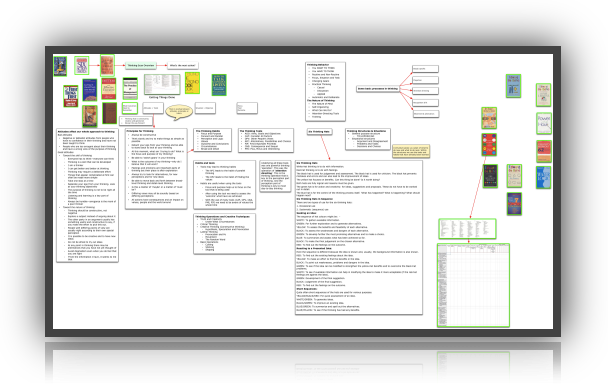Thinking broad and thinking detailed
From Teach Your Child How to Think (don’t let the title fool you) by Edward de Bono (includes links to many of his other books).

Amazon link: Teach Your Child How to Think

Calendarization is a means of converting concepts and ideas into daily action and this implies carrying out important broad and detailed work
Dense Reading and Dense Listening should probably precede broad and detail thinking
Ask yourself: What does this mean for me? (illustration) along with doing a PMI where appropriate
Thinking canvases are a means of documenting your thinking for later improvement.
The manager and the moron … thinking about the truly important things continue

For each thought fragment, concept, illustration, link, or text block
you encounter on rlaexp.com
your could EXPlore (rlaexp.com)
employing dense reading and dense listening
plus #thinking broad and thinking detailed
then ask yourself what does this mean for me? (illustration)
along with performing a PMI
in conjunction with visualizing the operacy involved

BROAD AND DETAIL
Also see Wisdom → Broad
Also see broad and specific
‘What is the broad idea here?’ .
‘For action we need the detailed idea.’
Deliberate thinking
Operacy — the thinking that goes into doing
Have you ever ‘travelled’ along a road?
Many times.
In fact there has always been a ‘detailed’ way in which you have gone along any road: car, coach, motor-cycle, bicycle, on foot, on horse etc.
‘Travel’ is the broad idea or general method and then there is the detailed idea on how the method is actually put into practice.
Moving from broad idea to detailed idea and back again is both an important thinking habit and an important thinking operation.
… ‘Get me a drink.’
… ‘Get me a soft drink.’
… ‘Get me a lemonade.’
We move from the broad to the detailed. In this case there are three levels.
The detail level is always the one we can carry out. If any soft drink would do, that would be the detail level.
… ‘I am going to reward him.’
… ‘I am going to give him some money as a reward:
… ‘I am going to give him $50 as a reward.’
Again we move from the broad intention to the actual detail of what is to be done.
In much of our thinking we do have to be detailed and specific and sometimes being ‘broad’ means being unable to give a detailed answer.
But there are other times when it is very useful to be able to work at the ‘broad’ level.
GENERATING ALTERNATIVES
In a concrete floor there is a hole that is filled with water. You want to get the water out of the hole.
‘I could suck the water out.’
‘I could lift the water out.’
‘I could displace the water.’
Each of these is a broad idea, a general method or a broad concept.
Once we have the broad idea we then go on to see in what ways that broad idea could be carried out as a detailed idea.
Suck the water out’ suggests a pump or a siphon.
‘Lift the water out’ suggests a small bucket, spoon, sponge or mop.
‘Displace the water’ suggests putting in stones or even a plastic bag filled with water and then removing these objects later.
Instead of immediately trying to find the detailed idea it is often more useful to define some broad ideas. Once you have the broad idea, you look around for actual ways of carrying it out in a detailed way.
It is very useful to get into the thinking habit of finding broad approaches to a matter or problem and then trying to work from these to specific details.
Generating ideas under the green hat or for an APC often needs to be done in this way.
EXTRACTING THE BROAD IDEA
Sometimes we start the other way round. Instead of setting out with a broad idea and then trying to find a detailed way of carrying out the idea, we can start with the detail and try to extract the broad idea that lies behind the detail.
A farmer has a pointed wooden stick that he jabs into the ground and then he drops a seed into the hole.
What is the broad idea here?
It could be: ‘Making holes to put seeds into’.
Or, it could be: ‘Placing the seeds below the ground’.
Once we have the broad idea, we can look around for other ways to do things. For example, we could invent a machine that might make several holes at once and automatically drop a seed in each. Or we might scatter the seeds over the surface of the ground and then put a layer of soil on top of them.
If we are seeking to improve or change something, the way we do it is to extract the broad idea. Once we have the broad idea we can do two things. We can see if a different broad idea may serve the purpose (what we want to achieve). Or, we can see if the broad idea can be carried out in a different and better way.
What are we trying to do?
What is the broad idea here?
Is there a better broad idea?
How else can we carry out the broad idea?
CONCEPT AND FUNCTION
We often use a lot of different words to describe the ‘broad idea’. broad idea, general method, principle, broad concept, concept, function
In some cases it is more appropriate to use one word rather than another.
‘What is the function of this switch?’
‘The concept in this course is teach-yourself.’
‘The principle is that of paying people by what they actually produce, not by time.’
The general method we use here is to separate casualties into three groups: those who can wait; those who cannot be saved; those who need urgent attention.
You should be aware of these different words. They do have slightly different meanings, but you would only confuse yourself by trying to remember the distinctions. Just think in terms of broad idea and detailed idea.
Often it is convenient to work at three levels: detailed idea, broad idea, broad approach.
Really there are detailed ideas (which can be carried out) and then broad ideas. Some broad ideas are broader than others just as some roads are broader than others.
SUMMARY
It is useful to be able to work at the level of both broad idea and detailed idea. Moving up and down between these levels is an important thinking operation and a useful habit.

Larger

|
![]()
